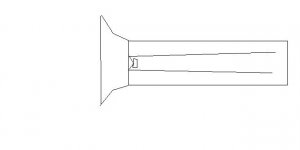I am doing a th for bass.
Would it also be possible to do a th for a fullrange?
The basic idea would be like the simple drawing here, a horn radiating from the back of the driver, turning back towards the driver and joining the front in a "new" horn.
This is just a basic idea i got, I do not have any experience with horns really, so i was wondering if it seems possible at all to get a good sounding design. As it seems i would be able to make the rear part to take the mid to upper bass, then the front part to blend in, and do the higher frequencies. Maybe add some high efficiency treble above 5k somewhere.
Edit:
Sorry, i just realized this would be a back loaded horn, with preferably another horn-loading at the front of the driver, but is there any way of calculating if there will be any interference between the two?
Would it also be possible to do a th for a fullrange?
The basic idea would be like the simple drawing here, a horn radiating from the back of the driver, turning back towards the driver and joining the front in a "new" horn.
This is just a basic idea i got, I do not have any experience with horns really, so i was wondering if it seems possible at all to get a good sounding design. As it seems i would be able to make the rear part to take the mid to upper bass, then the front part to blend in, and do the higher frequencies. Maybe add some high efficiency treble above 5k somewhere.
Edit:
Sorry, i just realized this would be a back loaded horn, with preferably another horn-loading at the front of the driver, but is there any way of calculating if there will be any interference between the two?
Attachments
Last edited:
I am doing a th for bass.
Would it also be possible to do a th for a fullrange?
The basic idea would be like the simple drawing here, a horn radiating from the back of the driver, turning back towards the driver and joining the front in a "new" horn.
This is just a basic idea i got, I do not have any experience with horns really, so i was wondering if it seems possible at all to get a good sounding design. As it seems i would be able to make the rear part to take the mid to upper bass, then the front part to blend in, and do the higher frequencies. Maybe add some high efficiency treble above 5k somewhere.
Edit:
Sorry, i just realized this would be a back loaded horn, with preferably another horn-loading at the front of the driver, but is there any way of calculating if there will be any interference between the two?
I had just about the same idea as of late, using two tubes of different diameters. In my case, it was imagined to be more a TL than a horn, which is also what your drawing suggests. I'd imagine that for the 1*wavelenght frequency, you'd have output in phase. For half wavelenght, it'd be at 180deg phase. Did not look at that further yet, but I'm interested in seeing what others have to say.
IG
As drawn, the driver's HF response will be choked off by the horn's high air mass and the rest will be comb filtered with its rear radiation which is what one sees in a TH's response. At minimum for it to work then, a BLH's rear filter chamber along with an intricate phase plug is required. This requires a very powerful motor and other driver specs not conducive to point source driver construction though, so a front horn will be required also, making it a compound horn alignment.
FWIW, what I proposed quite awhile back in the huge BIB thread is to use two drivers to create a wide BW hybrid TH, but with no way to sim it AFAIK it's not a high priority project for me.
GM
FWIW, what I proposed quite awhile back in the huge BIB thread is to use two drivers to create a wide BW hybrid TH, but with no way to sim it AFAIK it's not a high priority project for me.
GM
I feared the answer was going to be something like that. so the solution still seems to be a 2 or 3 way setup from 80-120hz, unfortunately.
But what about a bass reflex with just an obscenely big port just straight behind the driver (close to OB), and a horn loading at the front? Would that put a hard load on the driver as well?
But what about a bass reflex with just an obscenely big port just straight behind the driver (close to OB), and a horn loading at the front? Would that put a hard load on the driver as well?
Now you've created a crudely stepped TL, so the vent's harmonics will modulate the driver if not damped same as a TL. In this scenario, a higher Qt driver is required to offset having the high acoustic loading dragging it down, otherwise over-damping it. The driver's BW above ~2*pi*Fs will be damped down somewhat also, so typically a driver with a rising response like a Lowther has is required to compensate.
Arguably the best compromise then for drivers with a relatively flat HF response is a max flat impedance TL where Fp = Fs/Qts.
GM
Arguably the best compromise then for drivers with a relatively flat HF response is a max flat impedance TL where Fp = Fs/Qts.
GM
- Status
- This old topic is closed. If you want to reopen this topic, contact a moderator using the "Report Post" button.
